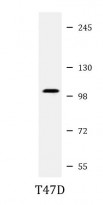ARG40139
anti-PLK4 antibody
anti-PLK4 antibody for Western blot and Human
Overview
| Product Description | Rabbit Polyclonal antibody recognizes PLK4 |
|---|---|
| Tested Reactivity | Hu |
| Tested Application | WB |
| Host | Rabbit |
| Clonality | Polyclonal |
| Isotype | IgG |
| Target Name | PLK4 |
| Antigen Species | Human |
| Immunogen | KLH-conjugated synthetic peptide between aa. 724-758 of Human PLK4. |
| Conjugation | Un-conjugated |
| Alternate Names | SAK; PLK-4; STK18; Serine/threonine-protein kinase PLK4; Serine/threonine-protein kinase Sak; EC 2.7.11.21; Serine/threonine-protein kinase 18; MCCRP2; Polo-like kinase 4 |
Application Instructions
| Application Suggestion |
|
||||
|---|---|---|---|---|---|
| Application Note | * The dilutions indicate recommended starting dilutions and the optimal dilutions or concentrations should be determined by the scientist. | ||||
| Positive Control | T47D |
Properties
| Form | Liquid |
|---|---|
| Purification | Purification with Protein A and immunogen peptide. |
| Buffer | PBS and 0.09% (W/V) Sodium azide. |
| Preservative | 0.09% (W/V) Sodium azide. |
| Storage Instruction | For continuous use, store undiluted antibody at 2-8°C for up to a week. For long-term storage, aliquot and store at -20°C or below. Storage in frost free freezers is not recommended. Avoid repeated freeze/thaw cycles. Suggest spin the vial prior to opening. The antibody solution should be gently mixed before use. |
| Note | For laboratory research only, not for drug, diagnostic or other use. |
Bioinformation
| Database Links |
Swiss-port # O00444 Human Serine/threonine-protein kinase PLK4 |
|---|---|
| Gene Symbol | PLK4 |
| Gene Full Name | polo-like kinase 4 |
| Background | This gene encodes a member of the polo family of serine/threonine protein kinases. The protein localizes to centrioles, complex microtubule-based structures found in centrosomes, and regulates centriole duplication during the cell cycle. Three alternatively spliced transcript variants that encode different protein isoforms have been found for this gene. [provided by RefSeq, Jun 2010] |
| Function | Serine/threonine-protein kinase that plays a central role in centriole duplication. Able to trigger procentriole formation on the surface of the parental centriole cylinder, leading to the recruitment of centriole biogenesis proteins such as SASS6, CENPJ/CPAP, CCP110, CEP135 and gamma-tubulin. When overexpressed, it is able to induce centrosome amplification through the simultaneous generation of multiple procentrioles adjoining each parental centriole during S phase. Phosphorylates 'Ser-151' of FBXW5 during the G1/S transition, leading to inhibit FBXW5 ability to ubiquitinate SASS6. Its central role in centriole replication suggests a possible role in tumorigenesis, centrosome aberrations being frequently observed in tumors. Also involved in deuterosome-mediated centriole amplification in multiciliated that can generate more than 100 centrioles. Also involved in trophoblast differentiation by phosphorylating HAND1, leading to disrupt the interaction between HAND1 and MDFIC and activate HAND1. Phosphorylates CDC25C and CHEK2. [UniProt] |
| Cellular Localization | Cytoplasm, cytoskeleton, microtubule organizing center, centrosome, centriole. Nucleus, nucleolus. Cleavage furrow. Note=Component of the deuterosome, a structure that promotes de novo centriole amplification in multiciliated cells that can generate more than 100 centrioles. Associates with centrioles throughout the cell cycle. According to PubMed:16244668, it is not present at cleavage furrows. [UniProt] |
| Calculated MW | 109 kDa |
| PTM | Ubiquitinated; leading to its degradation by the proteasome. Tyrosine-phosphorylated by TEC. [UniProt] |
Images (1) Click the Picture to Zoom In






